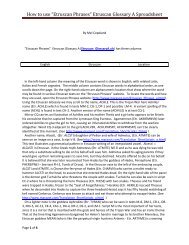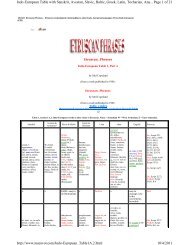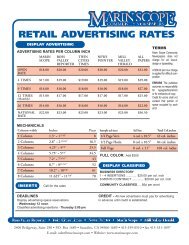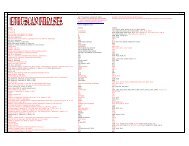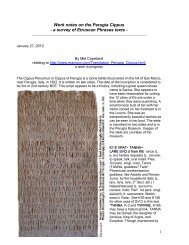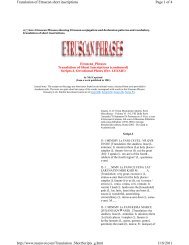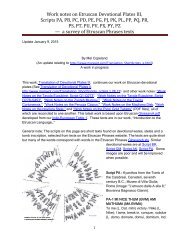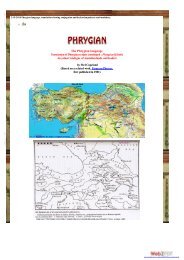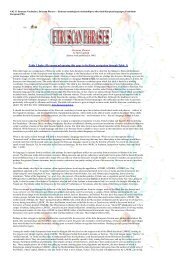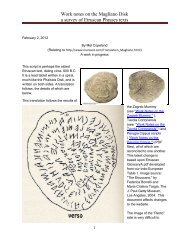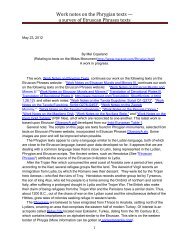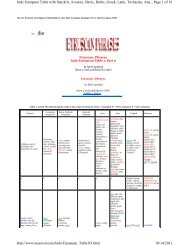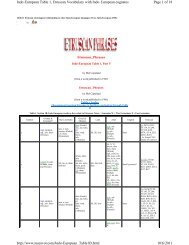<str<strong>on</strong>g>Work</str<strong>on</strong>g> <str<strong>on</strong>g>notes</str<strong>on</strong>g> <strong>on</strong> <strong>Etruscan</strong> <strong>Mirrors</strong> <strong>and</strong> <strong>Murals</strong>, <strong>Part</strong> I —a survey of <strong>Etruscan</strong> Phrases textsshe was sacrificing to Artemis — <strong>and</strong> carried her to the city of Aphidnae, in Attica, to be<strong>com</strong>eTheseus’ bride. The Dioscuri waited until Theseus was away <strong>on</strong> another adventure, thencaptured Aphidnae, <strong>and</strong> perhaps Athens as well, with the aid of Spartan <strong>and</strong> Arcadian armies.They rescued Helen, carried off Theseus’ mother, Aethra, <strong>and</strong> Peirithous’ sister Phisadië, <strong>and</strong>placed Theseus’ rival Menestheus <strong>on</strong> the Athenian thr<strong>on</strong>e.Script DM Divine Mirror, mirror fromVulciWhen it came time to marry off hisbrother Menelaüs, King Agamemn<strong>on</strong>decided to strike a bargain with KingTyndareüs, as Tyndareüs hadextended invitati<strong>on</strong>s throughoutGreece to marry off his daughter <strong>and</strong>all of the princes vied for her h<strong>and</strong>,including Idomeneus, who came fromCrete, <strong>and</strong> Odysseus who sent nogifts. However, powerful kingAgamemn<strong>on</strong> already had an edge up<strong>on</strong> the others, since he was married toHelen’s older sister Clytemnestra. Sohe struck the successful bargain withTyndareüs.(http://www.<strong>maravot</strong>.<strong>com</strong>/Divine_Mirror.html)The <strong>Etruscan</strong> versi<strong>on</strong> doesn’t exactlyrecord the same situati<strong>on</strong>. It seemsthat Helen was already seated <strong>on</strong> thethr<strong>on</strong>e of Sparta <strong>and</strong> as queen ofSparta struck the bargain herself.Agamemn<strong>on</strong> presented the pursedirectly to Helen under the approval ofthe gods.Here in Script DM we see <strong>on</strong> the top panel from right to left, the mother of Helen, Nemesis,seated next to Zeus, <strong>and</strong> next to the god are Heracles <strong>and</strong> Aphrodite. Their <strong>Etruscan</strong> names, leftto right are Thalna, Tinia, Hercle <strong>and</strong> Turan. We thought the spelling of “Thalna” was “Ralna,”but discovered that the <strong>Etruscan</strong> spelling of revenge THALIO (ΘALIV) which corresp<strong>on</strong>ds toretaliati<strong>on</strong> (L talio-<strong>on</strong>is). <strong>Etruscan</strong> names often carry the augmentative “na”, “ne,” as in Italian;i.e., RASNA, RASNE, RASNES. See PC-8, <str<strong>on</strong>g>Work</str<strong>on</strong>g> Notes <strong>on</strong> <strong>Etruscan</strong> Devoti<strong>on</strong>al Plates III. Thus,THALNA (ΘALNA) corresp<strong>on</strong>ds to Gr. Nemesis, revenge.Images of gods <strong>and</strong> heroes in classical mythology are often shown with totems with which they12
<str<strong>on</strong>g>Work</str<strong>on</strong>g> <str<strong>on</strong>g>notes</str<strong>on</strong>g> <strong>on</strong> <strong>Etruscan</strong> <strong>Mirrors</strong> <strong>and</strong> <strong>Murals</strong>, <strong>Part</strong> I —a survey of <strong>Etruscan</strong> Phrases textsare associated. Athena is associated with the owl, for instance. Likewise, Nemesis is associatedwith a goose, which is st<strong>and</strong>ing next to Thalna. TINIA is the <strong>Etruscan</strong> supreme god (Gr. Zeus, L.Jupiter). Next to him is the hero HERCLE (Gr. Heracles, L. Hercules) who is holding his sign, aclub. He presents to TINIA a cherub named EP OR (EP VR). We d<strong>on</strong>’t know why Hercle is in thepicture, since he is not menti<strong>on</strong>ed the story involving Helen’s abducti<strong>on</strong> by the Trojan Alex<strong>and</strong>er(Paris). However, a cherub named Eros (L. Cupid), the s<strong>on</strong> of Aphrodite (L. Venus, Etr. Turan)may have had something to do with causing Helen to fall in love with Alex<strong>and</strong>er. The storyinvolving Eros is also somewhat tangled, since Eros was believed to be am<strong>on</strong>g the first godscreated, preceding Aphrodite who was born out of the sea foam near Cyprus, when Uranus wascastrated. Hesiod says that Eros was <strong>on</strong> h<strong>and</strong> to greet her when she emerged from the sea.Also, Heracles <strong>and</strong> Aphrodite were not associated as lovers. She had married the lame fire-godHephaestus, but did not remain faithful to him very l<strong>on</strong>g. She had a protracted affair with Ares (L.Mars, Mavors, Etr. MARIS) <strong>and</strong> had children by him: Eros, Deimus (Fear), Phoebus (Panic) <strong>and</strong>Harm<strong>on</strong>ia. She also had brief affairs with two or three other gods. She repulsed the advances ofHermes until Zeus too pity <strong>on</strong> him <strong>and</strong> sent an eagle to snatch her s<strong>and</strong>al <strong>and</strong> carry it to him.The goddess had to submit to him in order to recover it. She bore Hermaphroditus, whose namewas <strong>com</strong>pounded of the names of his parents. The amorous god Priapus was reputed to be as<strong>on</strong> of Aphrodite by Di<strong>on</strong>ysus <strong>and</strong> Poseid<strong>on</strong> was said to be the father of Aphrodite’s s<strong>on</strong> Eryx,king of the regi<strong>on</strong> of western Sicily that was named for him, but others say Butes was the father.The sec<strong>on</strong>d panel of the Divine Mirror is more <strong>com</strong>plicated. From right to left we see an angelicbeing, LASA THIMRAE (ΘIMOAE). LASA THIMRAE is probably the Lasa of the ThimbraeanApollo. She recalls Cass<strong>and</strong>ra, who Propertius, in his Elegies, describes as amaenad. Cass<strong>and</strong>ra got her prophetic powers when sleeping in Apollo’s Thimbraean temple.The household goddess carries a w<strong>and</strong> of prophesy in her right h<strong>and</strong> <strong>and</strong> in the left h<strong>and</strong> whatappears to be an alabaster unguent bottle, seen frequently being carried in ladies' h<strong>and</strong>s in<strong>Etruscan</strong> murals. While we see Lasa Thimrae exiting <strong>on</strong> the right, <strong>on</strong> the left h<strong>and</strong> side of thepanel is an alarmed man with a Phrygian hat holding up his h<strong>and</strong> as in protest. His name isAECAI. Note the suffix, “ai,” in both AECAI <strong>and</strong> HELENAI. Helen's name is spelled HELENEIin Script MM). Aecai, here, is probably the s<strong>on</strong> of King Priam of Troy who prophesied that Pariswould bring destructi<strong>on</strong> to Troy. His name was Aesacus, s<strong>on</strong> of Priam by Arisbe. There is aninteresting refrain from the work, "Alex<strong>and</strong>ra," by Lycophr<strong>on</strong> of Calchis (3rd century B.C.) thatrefers to the firebr<strong>and</strong> up<strong>on</strong> Troy voiced through Aesacus:Alex<strong>and</strong>ra (31) "...I see thee hapless city, fired a sec<strong>on</strong>d time by Aeaceian h<strong>and</strong>s..."We can <strong>com</strong>pare this passage to others from the same work:Alex<strong>and</strong>ra (219) "...And would that my father had not spurned the nightly terrors of theoracle of Aesacus...""...wherein <strong>on</strong>e day hereafter the Tymphaean drag<strong>on</strong>, even the king of the Aethices,shall at a feast destroy Heracles sprung from the seed of Aeacus <strong>and</strong> Perseus <strong>and</strong> nostranger to the blood of Temenus..."13



